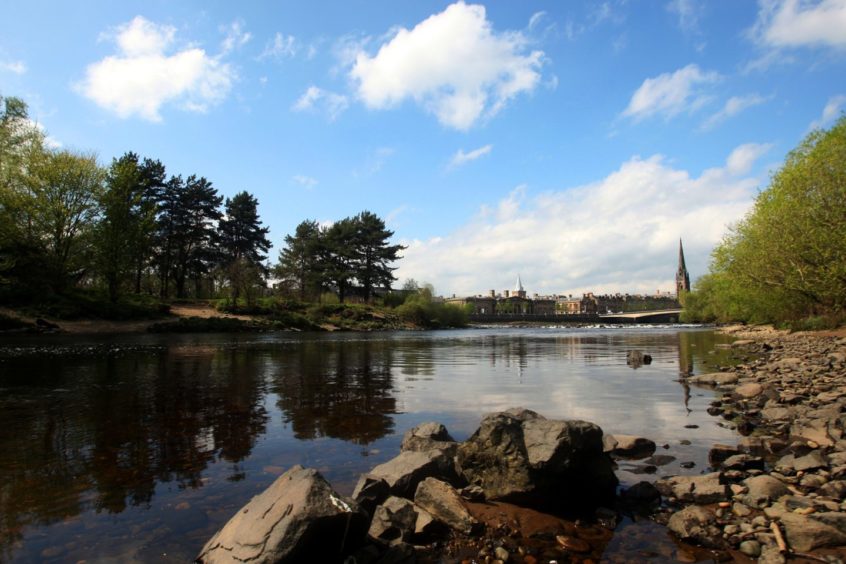Warming seas are affecting salmon in the Tay and that is “very worrying” for those whose livelihoods depend on the iconic river.
David Godfrey is the head ghillie at Tay Salmon Fisheries Company.
“Economically it’s very worrying.
“My job is taking people to catch salmon. If there’s no salmon, then I don’t have a job.
“That’s always a worry.”
What’s happening to the Tay salmon?
The Tay District Salmon Fisheries Board has noticed an increase in the proportion of larger salmon in the river.
That might initially sound like a good thing.
But unfortunately the overall numbers of salmon are said to be decreasing.

And there are fears the numbers of salmon returning to spawn could reach a tipping point.
Mr Godfrey says the presence of larger fish tells a story about how climate change is affecting the salmon’s life cycle.
There is now a general trend of fewer young salmon, called grilse, returning to the Tay after one winter at sea.
And this is a pattern repeated across Scottish rivers.
Mr Godfrey fears the downward trajectory will continue as the seas warm up.
Salmon have bounced back in the past, but will they again?
Tay Salmon has been running fishing trips along the river since 1899.
And even a century ago their records showed that salmon populations had a tendency to fluctuate.
In fact, Mr Godfrey said Tay Salmon Fisheries Company founder Peter Malloch is said to have described salmon numbers in the 1920s as critically low.
He said numbers subsequently bounced back but climate change had put a question mark over whether or not they will bounce back again.
Although he does not see the situation as all “doom and gloom”.
“I personally sit on the river for 240 days a year and we see plenty salmon going through.”
However, he added there were “not the numbers there was, 40 years ago.”
Scottish salmon have to swim further to find food
Salmon travelling out to sea rely on zooplankton to survive.
Zooplankton are small aquatic microorganisms that provide a vital food source for marine life.
Mr Godfrey described them as “temperature critical” and said warming seas mean they are moving north.
“These very small zooplankton that are the first feeding source as the salmon are making their way through the ocean are very temperature critical.
“If that is migrating further north, they might not be getting what they need to feed as they’re heading out to the big buffet in the middle of the North Atlantic.”
Mr Godfrey said the picture was different at higher latitudes where the seas were cooler, around Norway and Iceland.
“Our fish have got a five, six, seven hundred mile journey before they get to the same spot.”
Uncertainty as Scottish Rivers enter ‘new phase’
Dr David Summers has spent 30 years studying and managing freshwater fisheries.
He started his career with the Department of Agriculture and Fisheries for Scotland.
Dr Summers said there was no doubt salmon were spending “more time at sea” before returning to the Tay.
This is not peculiar to the Tay but is happening “across the board”.
Most of the salmon returning to the river have spent two or three winters at sea.
He said the reason for this is because their shifting feeding grounds are resulting in them growing more slowly.
“The average size of salmon is, curiously, actually going up.
“Also, the growth rate is going down. Or has dropped compared to what it was.
“Because the fish are growing more slowly at sea they’re spending more time at sea before they come back.”
But what does the future hold?
Dr Summers said there had been fluctuations in grilse.
“If you go back to the 1950s, again there was a higher proportion of multi sea-winter fish and fewer grilse.
“During the 1960s the grilse increased. Then there was a period until very recently when it was grilse dominating.
“Now it’s switched the other way again,”
He also sees climate change as a game changer along the river.
“We’re in a new kind of phase because climatic conditions haven’t been like this in recorded history.”
So, the picture is fewer fish but a higher proportion of bigger salmon.
“At the end of the day, what it does mean is there are a lot fewer fish than there were overall 30 or 40 years ago.
“What we are seeing is less fish now but more bigger ones.
“From an angling perspective for example, some anglers might be excited by that.
“But the trend is not in a good direction.”
‘Not a healthy situation’ as salmon populations close to tipping point
Dr Summers said fewer fish overall and salmon taking longer to return to spawn threatened the future viability of the Tay as a fishing river.
Anglers are already required by law to release any salmon caught along the Tay between January and March.
The legislation aimed at preserving salmon stocks was introduced in 2015.
But with factors out at sea beyond the control of those managing the river, Dr Summers said it was “not a healthy situation”.

He described the breeding population of salmon as “probably about adequate”.
“It does appear that the spawning population is just enough.
“But if these trends continue, our fear is that one day this spawning population might become insufficient in future.
“If the marine climate continues to change and feeding areas go further north, then who knows what happens then.”
Is climate change really to blame?
The factors affecting salmon populations are a matter of fierce debate.
Pollution, parasites and disease caused by fish farming have been blamed for killing wild salmon.
The impact of hydro-electric dams and predators such as seals and seabirds have also been highlighted.
But Dr Summers said these factors were “not driving the trend itself”.
“Other marine fish are behaving in different ways over exactly the same timescale.
“These other factors are there too. And when sea survival is really low, then these other factors might have a bigger impact than they would have had 30 years ago.”











